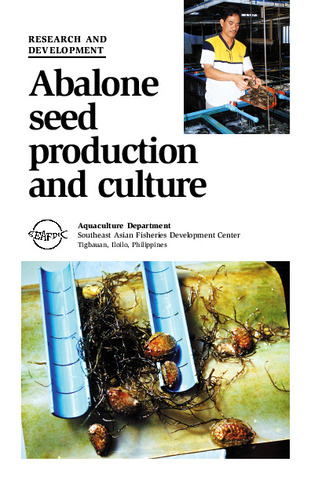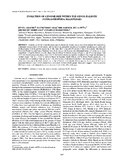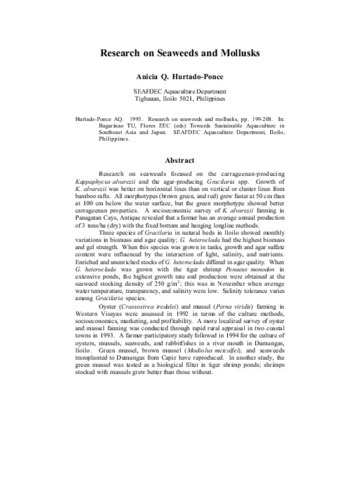Use of thraustochytrid Schizochytrium sp. as source of lipid and fatty acid in a formulated diet for abalone Haliotis asinina (Linnaeus) juveniles
| dc.contributor.author | de la Peña, Milagros R. | |
| dc.contributor.author | Teruel, Myrna B. | |
| dc.contributor.author | Oclarit, Jose M. | |
| dc.contributor.author | Amar, Mary Jane A. | |
| dc.contributor.author | Ledesma, Ellen Grace T. | |
| dc.date.accessioned | 2016-10-06T01:01:23Z | |
| dc.date.available | 2016-10-06T01:01:23Z | |
| dc.date.issued | 2016 | |
| dc.identifier.citation | de la Peña, M. R., Teruel, M. B., Oclarit, J. M., Amar, M. J. A., & Ledesma, E. G. T. (2016). Use of thraustochytrid Schizochytrium sp. as source of lipid and fatty acid in a formulated diet for abalone Haliotis asinina (Linnaeus) juveniles. Aquaculture International, 24(4), 1103-1118. | en |
| dc.identifier.issn | 0967-6120 | |
| dc.identifier.uri | http://hdl.handle.net/10862/3074 | |
| dc.description.abstract | The effects of using thraustochytrid Schizochytrium sp. as source of lipid and fatty acids in a formulated diet on growth, survival, body composition, and salinity tolerance of juvenile donkey’s ear abalone, Haliotis asinina, were investigated. Treatments consisted of diets either containing a 1:1 ratio of cod liver oil (CLO) and soybean oil (SBO) (Diet 1) or thraustochytrid (Diet 2) as source of lipid and fatty acids at 2 % level. Natural diet Gracilariopsis heteroclada (Diet 3) served as the control. No significant difference in growth was observed in abalone fed Diet 3 (SGR: 5.3 % BW day−1; DISL: 265 μm day−1) and Diet 2 (SGR: 5.2 % BW day−1; DISL: 255 μm day−1). Survival ranged from 78 to 85 % for all treatments and was not significantly different from each other. A 96-h salinity stress test showed highest survival of 84 % in abalone fed Diet 2 compared with those fed diets 1 and 3 (42 %). The high growth rate of abalone fed Diet 2 and high tolerance to low salinity could be attributed to its high DHA content (8.9 %), which resulted to its high DHA/EPA ratio of 10.5 %. These fatty acids play a significant role in abalone nutrition. The fatty acid profile of abalone meat is a reflective of the fatty acid profile of the oil sources in the diet. The present study suggests that the use of Schizochytrium oil in lieu of CLO and SBO can support good growth of abalone which is comparable with abalone fed the natural seaweeds diet. | en |
| dc.language.iso | en | en |
| dc.publisher | Springer Verlag | en |
| dc.subject | Haliotis | en |
| dc.subject | Haliotis asinina | en |
| dc.title | Use of thraustochytrid Schizochytrium sp. as source of lipid and fatty acid in a formulated diet for abalone Haliotis asinina (Linnaeus) juveniles | en |
| dc.type | Article | en |
| dc.identifier.doi | 10.1007/s10499-016-9974-3 | |
| dc.citation.volume | 24 | |
| dc.citation.issue | 4 | |
| dc.citation.spage | 1103 | |
| dc.citation.epage | 1118 | |
| dc.citation.journalTitle | Aquaculture International | en |
| dc.subject.asfa | growth | en |
| dc.subject.asfa | shellfish culture | en |
| dc.subject.asfa | lipids | en |
| dc.subject.asfa | fatty acids | en |
| dc.subject.asfa | feeding experiments | en |
| dc.subject.asfa | marine molluscs | en |
| dc.subject.asfa | salinity tolerance | en |
| dc.subject.asfa | seaweeds | en |
| dc.subject.asfa | fish oils | en |
| dc.subject.asfa | fish culture | en |
| dc.identifier.essn | 1573-143X | |
| dc.subject.scientificName | Schizochytrium | en |
| dc.subject.scientificName | Gracilariopsis heteroclada |
Files in this item
| Files | Size | Format | View |
|---|---|---|---|
|
There are no files associated with this item. |
|||
This item appears in the following Collection(s)
-
Journal Articles [1256]
These papers were contributed by Department staff to various national and international journals.



